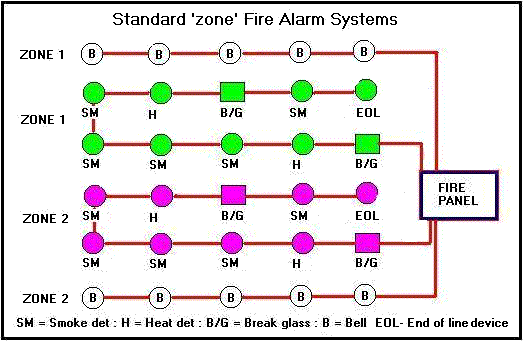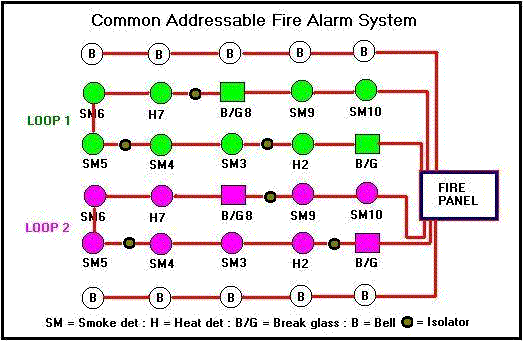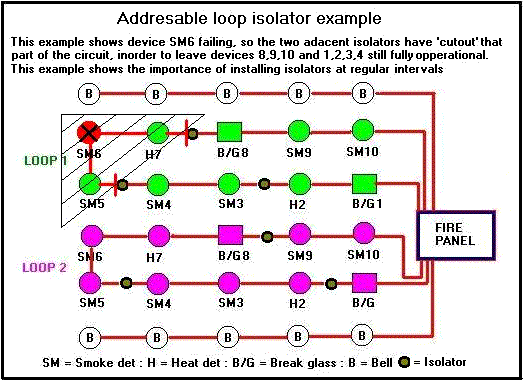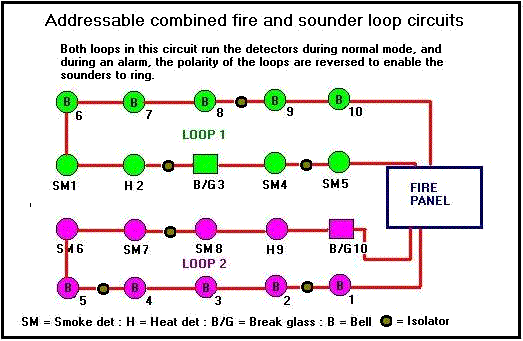Fire Alarm Installations
This section forms a guide to the types of fire alarm system available of the market today.
3.Addressable Fire Alarm Systems
Fire alarms provide protection to occupants of a building, and its
contents if the system is monitored or has a ‘halon’ gas installation
provided.
A fire alarm system is installed according to the type of use the
building may have, for instance, you will have higher protection (ie, smoke
detector and bell in every room of a hotel , but may only find two bells in a
warehouse used for storage).
There are generally two types of fire alarm system available today analogue
and addressable, though you may find in older installations hand bell
systems, and 230 volt break glass systems (without power failure back-up).
2. Analogue Fire Alarm systems
Analogue Fire alarm systems consist of a fire alarm panel, which will have a number of ‘zones’ run from it (minimum of two detection and two bell zones).
Each detection zone is run in a radial from the fire alarm panel to
various break glasses, laser, smoke and heat detectors. A zones is generally run
to cover a specific area (ie, the first floor is one zone, ground floor is
another zone).
These systems must be wired in fire resistant cables for the bell
circuits, and can be wired in a standard cable for the detection circuit, though
it is normally good practice within the trade to install the entire system in a
fire resistant cable (ie FP200, PYRO), Cable sizes normally used are 1.5mm for
detection, 2.5mm for sounders.
At the end of the radial detection circuit, an ‘end of line’ device
is installed ( found inside or beside the last device). This device monitors the
circuit to ensure that it has not been damaged or cut between it and the panel,
to ‘guarantee’ the circuit will work in the event of an alarm.
The bell circuits on these systems work in a similar fashion, utilizing
two zones, but with one crucial difference: the two bell zones must criss cross
each other, ie bell 1 is on zone1, bell 2 is on zone 2, bell3 is on zone1, bell
4 is on zone2 and so on….
The idea is, that if one of the zones fail for any reason, the next bell
away from the failed one is close by (so the alarm can still be heard).
The bell circuit will also have an end of line device fitted in the last
bell on each circuit for monitoring purposes.
In the event of a fire, one of the devices should be triggered on one of
the zones at the fire alarm panel. The fire alarm panel will illuminate that
zone, which will then enable cross reference to the chart on the panel to see
where in the building the fire may be (ie, 1st floor).

3. Addressable Fire Alarm systems
Addressable fire alarms are available in two main types of system,
the most common types are:
1. Loops for detection, and radials for the sounders
2.
Loops that can both act for detection and sounders together
These systems must be wired in a fire resistant cable (ie, FP200, and PYRO) , cable size normally used is 2.5mm.
1.
Loops for detection, and radials for the sounders
This type of system requires two individual circuits to do two separate
tasks.
The loops are run from the panel, through various devices (smoke
detectors, break glasses, heat detectors, interfaces) around the selected area
of the building, and then back to the panel. The loop also has ‘isolator’
devices installed in the loop at selected points, (normally where the loop cable
passes through a wall).
Loop isolators are installed to protect the continuity of the circuit in
the event that the detection loop is damaged for whatever reason. If damage
occurs to a stretch of cable, the isolators connected to either end of that
piece of the loop will ‘cut it out’ of the circuit – isolating it from the
remaining devices, and with the circuit being wired in a loop fashion, none of
the remaining devices either side of the isolated cable have been lost from the
detection circuit.
Each device on the loop is either given a number through tagging the
base of the detector (Apollo bases use this method), or the device itself is
programmed by the commissioning engineer using a laptop type PC. Each devices
number is unique to that loop, and once all devices are numbered, the fire alarm
panel is then programmed to recognize ie, device 1, to be in the foyer : device
2, to be on stair case 1 landing: device3, to be in bedroom1 etc….
In the event of a fire, the panel will show the location of the device
that has been triggered, providing the fire brigade the best information as to
where the fire may be.
These systems utilizes a minimum of two loops, generally one per floor, with upto a maximum of 128 devices on a loop.


2. Loops that can both act for detection and sounders together
These systems are similar to the systems mentioned above, but do
not have a separate circuits for the sounders.
These loops are capable of changing the polarity of the circuit in the
event of a fire to make the sounders ring. (ie red is plus, black is negative
during detection mode, and red is negative, black is positive during sounding of
an alarm).
